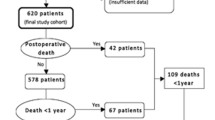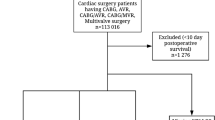Abstract
Background
Whether the intermediate care unit (IMCU) is beneficial for the oldest-old (aged ≥ 80 years) general surgical patients still remains unknown. We aimed to investigate the impacts of IMCU on the clinical outcomes and cost in this population.
Methods
A retrospective, pre- and postintervention study was performed in this population in a university teaching hospital. The primary outcome was the occurrence of life-threatening complications including death or unplanned ICU admission after the surgeries. Secondary outcomes included the comparisons of the hospitalization expenses, the hospital length of stay (LOS) and the postoperative LOS between the pre-IMCU group and the IMCU group.
Results
Two hundred and seventeen patients were enrolled, including 98 in the pre-IMCU group and 119 in the IMCU group. After the introduction of IMCU, the occurrence of life-threatening complications significantly dropped from 11.2 to 2.5% (P = 0.012). The total hospitalization expenses showed a nonsignificant decreasing trend in the IMCU group (pre-IMCU group: 85856.3 ± 66583.7 RMB vs IMCU group: 78936.4 ± 36710.4 RMB). The treatment fee was much lower in the IMCU group (IMCU group: 4930.0 ± 4280.2 RMB vs pre-IMCU group: 7378.2 ± 10096.7 RMB, P = 0.017). Both the hospital LOS (IMCU group: 20.3 ± 10.3 days vs pre-IMCU group: 19.5 ± 9.0 days) and the postoperative hospital LOS (IMCU group: 12.0 ± 8.1 days vs pre-IMCU group: 11.2 ± 7.0 days) were not statistically different in the two groups.
Conclusions
The allocation of the oldest-old surgical patients who do not need organ support therapy in the ICU to IMCU rather than in the standard wards was associated with a significant decrease in postoperative life-threatening complications and treatment fee.
Trial registration
This study was registered at https://www.chictr.org.cn (ChiCTR2000030639).



Similar content being viewed by others
Data availability
The datasets in this study are available from the corresponding author on reasonable request.
References
Kwok AC, Semel ME, Lipsitz SR et al (2011) The intensity and variation of surgical care at the end of life: a retrospective cohort study. Lancet 378:1408–1413. https://doi.org/10.1016/S0140-6736(11)61268-3
Lidsky ME, Thacker JKM, Lagoo-Deenadayalan SA et al (2012) Advanced age is an independent predictor for increased morbidity and mortality after emergent surgery for diverticulitis. Surgery 152:465–472. https://doi.org/10.1016/j.surg.2012.06.038
Joseph B, Zangbar B, Pandit V et al (2016) Emergency general surgery in the elderly: too old or too frail? presented orally at the surgical forum of the American college of surgeons 100th annual clinical congress, San Francisco, CA, October 2014. J Am Coll Surg 222:805–813. https://doi.org/10.1016/j.jamcollsurg.2016.01.063
Chow WB, Rosenthal RA, Merkow RP et al (2012) Optimal preoperative assessment of the geriatric surgical patient: a best practices guideline from the American college of surgeons national surgical quality improvement program and the American geriatrics society. J Am Coll Surg 215:453–466. https://doi.org/10.1016/j.jamcollsurg.2012.06.017
Partridge J, Sbai M, Dhesi J (2018) Proactive care of older people undergoing surgery. Aging Clin Exp Res 30:253–257. https://doi.org/10.1007/s40520-017-0879-4
Balentine CJ, Naik AD, Berger DH et al (2016) Postacute care after major abdominal surgery in elderly patients intersection of age, functional status, and postoperative complications. JAMA Surg 151:759–766. https://doi.org/10.1001/jamasurg.2016.0717
Sheetz KH, Waits SA, Krell RW et al (2013) Improving mortality following emergent surgery in older patients requires focus on complication rescue. Ann Surg 258:614–617. https://doi.org/10.1097/SLA.0b013e3182a5021d
Pinto BB, Ben Rached MAK, Walder B (2016) Risk prediction instruments to guide perioperative care in elderly patients with advanced disease: a basic necessity. Eur J Anaesthesiol 33:875–877. https://doi.org/10.1097/EJA.0000000000000502
Cooper Z, Mitchell SL, Gorges RJ et al (2015) Predictors of mortality up to 1 year after emergency major abdominal surgery in older adults. J Am Geriatr Soc 63:2572–2579. https://doi.org/10.1111/jgs.13785
Gillies MA, Power GS, Harrison DA et al (2015) Regional variation in critical care provision and outcome after high-risk surgery. Intensive Care Med 41:1809–1816. https://doi.org/10.1007/s00134-015-3980-1
Vester-Andersen M, Lundstrom LH, Moller MH et al (2014) Mortality and postoperative care pathways after emergency gastrointestinal surgery in 2904 patients: a population-based cohort study. Br J Anaesth 112:860–870. https://doi.org/10.1093/bja/aet487
Pedoto A, Heerdt PM (2009) Postoperative care after pulmonary resection: Postanesthesia care unit versus intensive care unit. Curr Opin Anaesthesiol 22:50–55. https://doi.org/10.1097/ACO.0b013e32831d7b25
Prin M, Wunsch H (2014) The role of stepdown beds in hospital care. Am J Respir Crit Care Med 190:1210–1216. https://doi.org/10.1164/rccm.201406-1117PP
Vincent JL, Rubenfeld GD (2015) Does intermediate care improve patient outcomes or reduce costs? Crit Care 19:1–5. https://doi.org/10.1186/s13054-015-0813-0
Blackburn HN, Clark MT, Moorman JR et al (2018) Identifying the low risk patient in surgical intensive and intermediate care units using continuous monitoring. Surgery 163:811–818. https://doi.org/10.1016/j.surg.2017.08.022
Teli M, Morris-Stiff G, Rees JR et al (2008) Vascular surgery, ICU and HDU: a 14-year observational study. Ann R Coll Surg Engl 90:291–296. https://doi.org/10.1308/003588408X241980
Solberg BCJ, Dirksen CD, Nieman FHM et al (2014) Introducing an integrated intermediate care unit improves ICU utilization: a prospective intervention study. BMC Anesthesiology. https://doi.org/10.1186/1471-2253-14-76
White P, Song D (1999) New criteria for fast-tracking after anesthesia: a comparison with the odifided Aldrete’s scoring system. Anesth Analg 88:1069–1072. https://doi.org/10.1097/00000539-199905000-00018
Mendis N, Hamilton GM, McIsaac DI et al (2019) A Systematic review of the impact of surgical special care units on patient outcomes and health care resource utilization. Anesth Analg 128:533–542. https://doi.org/10.1213/ANE.0000000000003942
Vester-Andersen M, Waldau T, Wetterslev J et al (2015) Randomized multicentre feasibility trial of intermediate care versus standard ward care after emergency abdominal surgery (InCare trial). Br J Surg 102:619–629. https://doi.org/10.1002/bjs.9749
Turner J, Edwards AE, Gemmell LW et al (2006) Does a high dependency unit enhance the postoperative care of fractured neck of femur patients Pragmatic randomised trial. Care Crit Ill 22:24–27
Fujii T, Uchino S, Takinami M (2016) Life-threatening complications after postoperative intermediate care unit discharge. Eur J Anaesthesiol 33:22–27. https://doi.org/10.1097/EJA.0000000000000321
Weerink LBM, Gant CM, van Leeuwen BL et al (2018) Long-term survival in octogenarians after surgical treatment for colorectal cancer: prevention of postoperative complications is key. Ann Surg Oncol 25:3874–3882. https://doi.org/10.1245/s10434-018-6766-1
Ghaferi AA, Dimick JB (2016) Importance of teamwork, communication and culture on failure-to-rescue in the elderly. Br J Surg 103:e47–e51. https://doi.org/10.1002/bjs.10031
Mohammed Iddrisu S, Considine J, Hutchinson A (2018) Frequency, nature and timing of clinical deterioration in the early postoperative period. J Clin Nurs 27:3544–3553. https://doi.org/10.1111/jocn.14611
Broens SJL, He X, Evley R et al (2017) Frequent respiratory events in postoperative patients aged 60 years and above. Ther Clin Risk Manag 13:1091–1098. https://doi.org/10.2147/TCRM.S135923
Habre W, Peták F (2014) Perioperative use of oxygen: variabilities across age. Br J Anaesth 113:ii26–ii36. https://doi.org/10.1093/bja/aeu380
Sun Z, Sessler DI, Dalton JE et al (2015) Postoperative hypoxemia is common and persistent: a prospective blinded observational study. Anesth Analg 121:709–715. https://doi.org/10.1213/ANE.0000000000000836
Michard F, Sessler DI, Saugel B (2018) Non-invasive arterial pressure monitoring revisited. Intensive Care Med 44:2213–2215. https://doi.org/10.1007/s00134-018-5108-x
Ackland GL, Brudney CS, Cecconi M et al (2019) Perioperative quality initiative consensus statement on the physiology of arterial blood pressure control in perioperative medicine. Br J Anaesth 122:542–551. https://doi.org/10.1016/j.bja.2019.01.011
Acknowledgements
We especially thank the staff in the department of Information in our hospital who made the data collection and evaluation possible.
Funding
This work did not receive any grant from funding agencies in the public, commercial or not-for-profit sectors.
Author information
Authors and Affiliations
Contributions
All authors attest that they meet the current International Committee of Medical Journal Editors (ICMJE) criteria for Authorship. LW contributed to methodology, formal analysis, investigation and writing the original draft; JQ contributed to formal analysis and investigation; XZ contributed to resources and visualization; LC helped in verification. ZL contributed to data curation; WX helped in conceptualization, methodology, writing, review and editing; LY helped in conceptualization, methodology and supervision.
Corresponding authors
Ethics declarations
Conflict of interest
The authors have declared no conflicts of interest for this article.
Ethical approval
The protocol was approved by the Institutional Ethics Committee of the Six Affiliated Hospital of Sun Yat-sen University.
Informed consent
A waiver for informed consents was allowed by the ethic committee in view of the fact that data in this study were analyzed retrospectively and anonymously.
Additional information
Publisher's Note
Springer Nature remains neutral with regard to jurisdictional claims in published maps and institutional affiliations.
Rights and permissions
About this article
Cite this article
Wang, L., Qing, J., Zhang, X. et al. Effects of the intermediate care unit on the oldest-old general surgical patients: a retrospective, pre- and postintervention study. Aging Clin Exp Res 33, 1557–1566 (2021). https://doi.org/10.1007/s40520-020-01662-5
Received:
Accepted:
Published:
Issue Date:
DOI: https://doi.org/10.1007/s40520-020-01662-5




